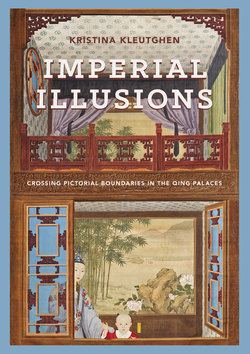Читать книгу Imperial Illusions - Kristina Kleutghen - Страница 36
Оглавлениеdemonstrate the presence and power of successfully deceptive pictorial illusionism in Chinese painting well in advance of European contact and the later introduction of perspectival illusionism. Long before scenic illusions were affixed to Qing imperial walls, deceptively illusionistic murals occupied an important historical position in Chinese painting. Therefore, tracing the history of this type of painting and responses to it contextualizes scenic illusion paintings within the much larger narrative of Chinese painting rather than isolating them. Specifically, ideas about illusionistic painting were significantly shaped by literati criticism of trained technique and realistic depiction in paintings produced for popular consumption as inferior to the originality and spontaneity of paintings produced for self-expression. Thus, when European paintings began to circulate in China during the late sixteenth century, elite aesthetic responses to them were nuanced by this discourse into something more than simply reactions to foreignness. Amid the literati-driven “cultural politics of the brushstroke” that arose in response to the challenges of European representational modes, however,3 not only were these new imported styles and techniques approved of at the imperial level, but even the most dismissive critics could not deny the deceptive power of the foreign techniques. Tracing this trajectory into the Kangxi reign frames the late imperial introduction of European illusionistic painting within both the long history of Chinese paintings and the shorter High Qing era of Sino-European artistic engagement vis-à-vis the missionary artists at court, which together created the diverse pictorial environment in which scenic illusion paintings would develop in the late 1720s.
The Rise and Fall of Murals
Textual sources record the presence of illusionistic murals inside palaces and public spaces from at least the Western Han through Yuan dynasties, but the relatively few extant examples (compared to the innumerable portable paintings) are found almost exclusively in religious and mortuary contexts.4 Within these liminal spaces of supernatural contact and otherworldly access, tomb and temple murals demonstrate how large architectural surfaces could be transformed into permeable membranes connecting the human and suprahuman realms. Over the centuries, a consistent visual language of supernatural motifs in these murals helped transform walls into the borders between the mundane and magical worlds.5 The persistent presence of murals in early and medieval tombs marks the paintings as essential to conceptualizing the overall space and purpose of the tomb: murals complete the relationship between tomb occupant(s), material contents, and spatial layout to create a fully realized mortuary world that was distinct from the human realm.6 Tomb murals were, however, primarily produced for the dead. With the renewed interest in Daoism and the rise of Buddhism among the tumultuous fragmentation of post-Han medieval China, the emphasis on the supernatural and otherworldly in murals expanded aboveground to temples and cave grottoes, which were firmly situated within the realm of the living.7
